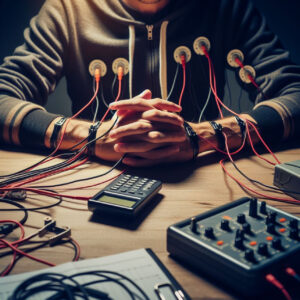

How To Tell When Someone Is Lying?
Have you ever wondered if someone is lying to you? Then, let us discuss how to spot a liar and uncover the truth. Lying is a common and complex human behavior with various motives and consequences. Sometimes, people lie to protect themselves or others from harm, embarrassment, or rejection. Other times, people lie to gain an advantage, deceive, or manipulate.
Whatever the reason, lying can damage trust and relationships, so it is crucial to spot when someone is not honest with you. But how can you do that? How can you tell if someone is lying?


There is no easy or foolproof way to detect lies. Also, no magic formula or device can reveal the truth with 100% accuracy. However, some techniques and strategies can help you improve your lie-detection skills and increase your chances of uncovering the truth.
In today’s article, I will show you how to spot a liar by using the following methods:
- Observing body language and eye movement
- Listening to verbal responses and voice tone
- Asking for more information and details
- Using unexpected questions and challenges
- Imposing cognitive load and stress
- Checking for consistency and coherence
- Using other sources of evidence and verification
With these methods, you can look for clues and signs that indicate deception in the person you are talking to. You will also be able to avoid common myths and mistakes that can lead you astray when trying to detect lies. However, before we dive into these methods, I need to make some important disclaimers:
Disclaimers
- Firstly, these methods are not 100% accurate or reliable. These are based on scientific research and practical experience but are not infallible. Additionally, there may be cases where you misinterpret someone’s behavior or miss some subtle cues. There may also be cases where someone is very good at lying and hiding their emotions.
- Secondly, these methods are not meant to accuse or confront anyone of lying. They hope to help you gather information and evidence that can help you make an informed judgment. Importantly, be mindful of the potential for bias and error when using these methods.
- Thirdly, these methods are meant to supplement trust or communication. Moreover, they aim to increase them when there is doubt or suspicion. Always try to communicate openly and honestly with the person you are talking to and give them the benefit of the doubt unless there is strong evidence otherwise.
With these disclaimers in mind, let’s begin our guide on how to spot a liar!
Observing Body Language and Eye Movements


Observing body language and eye movements is one of the most popular methods to spot a liar and uncover the truth. Body language is nonverbal communication through gestures, posture, facial expressions, and voice. Eye movements are the direction and duration of our gaze when speaking or listening.
Both body language and eye movements can reveal clues about the emotional state, cognitive load, and intentions of the person we are talking to. By observing their behavior, we can identify potential signs of deception. Some of the symptoms of fraud that we can look for in body language and eye movements are:
- Involuntary facial expressions. Micro-expressions are spontaneous facial expressions that are difficult to control. They can reveal a person’s genuine emotions, even if they are trying to lie. Only some people are born with the ability to detect micro-expressions, but anyone can learn with practice. A person lying may show a micro-expression of distress, such as a frown or a furrowed brow.


- Nose touching and mouth covering. People tend to touch their noses more when lying. The itchiness in your nose may be caused by a surge of adrenaline that causes the blood vessels in your nose to dilate. A person lying may try to cover their mouth with their hand or place it near their mouth as if they are trying to keep their words in. The muscles in the mouth and lips may tighten involuntarily when someone feels stressed, anxious, or angry.
- Eye movements. However, it is essential to note that eye movements are not always a reliable indicator of deception. People tend to blink more rapidly (eye flutter) as they’re telling a lie. Additionally, people (especially men) might rub their eyes more when lying. Pay attention to the blink rate. People who disagree with something may blink more slowly or longer than usual.
- Eye contact. People often believe that liars avoid eye contact, but this is not always true. Some liars may maintain too much eye contact as if trying to convince you of their honesty. Others may look away or break eye contact more often as if they are uncomfortable or distracted. The key to detecting deception is to be aware of the person’s usual way of eye contact. If they start to avoid eye contact or make excessive eye contact, it could be a sign that they are lying.
- Pupil dilation. The pupils of the eyes may dilate (expand) when a person lies, increasing arousal or stress. However, this sign may be hard to notice or influenced by other factors, such as lighting, drugs, or emotions.
- Head movements. A person lying may move their head differently, such as nodding or shaking it incongruently with what they are saying or moving it between several different positions. They may also tilt their head to the side as if unsure or confused.
These are some signs of deception you can look for in body language and eye movements. But, consider that these signs are not definitive or conclusive. They are only indicators of possible deception and may vary depending on the person, the situation, and the context. Therefore, you should always look for multiple signs that occur together or in sequence rather than relying on a single cue. Also, compare the person’s current behavior to their normal behavior. It will allow you to see if the person’s behavior is consistent with their baseline behavior or if any changes or deviations may indicate deception.
Listening to Verbal Responses and Voice Tone


Another method to spot a liar and uncover the truth is listening to verbal responses and voice tone. Verbal responses are the words and sentences that a person uses when speaking. Voice tone is the pitch, volume, speed, and quality of a person’s voice. Both verbal responses and voice tone can reveal clues about the cognitive load, emotional state, and intentions of the person we are talking to. By observing their speech, we can identify potential signs of deception. Some of the symptoms of fraud that we can look for in verbal responses and voice tone are the following:
- Lack of detail. A person lying may provide less detail or information than who is telling the truth. This is because lying requires more mental effort and memory than telling the truth, and liars may have trouble inventing or remembering details on the spot. A person telling a lie may also avoid answering directly or give vague or evasive answers.
- Lack of emotion. Additionally, they may show less emotion or affect than those telling the truth. Telling a lie requires more cognitive control and inhibition than telling the truth, and liars may suppress their feelings to appear more credible. Moreover, they may sound less direct and personal, using more formal or distancing language (such as I do not instead of I didn’t).
- Lack of spontaneity. Also, they may show less spontaneity or fluency than those telling the truth. Lying requires more planning and preparation than telling the truth, and liars may rehearse or script their responses in advance. They may pause, use more filler words (such as um or uh), or repeat themselves more often.
- Voice changes. Furthermore, a person lying may exhibit differences in their vocal patterns that indicate increased physiological arousal or stress. These changes may include higher pitch, faster speed, lower volume, more hesitation, more throat clearing, more coughing, more swallowing, more sighing, more laughing, or more vocal fry (a creaky sound at the end of sentences).
These are some red flags that may indicate that someone is being dishonest. However, remember that these signs can be present in people who are telling the truth and those who are lying. It is essential to consider all of the evidence, including the context of the conversation and the person’s normal behavior. Therefore, you should always look for multiple signs that occur together or in sequence rather than relying on a single cue. You should also compare the current speech of the person to their baseline speech, which is how they speak when they are relaxed and telling the truth. With this, you can identify any changes or inconsistencies that may be signs of deception.
Asking for More Information and Details


Another way to spot a liar and uncover the truth is by asking for more information and details. This method involves probing the person you are talking to with follow-up questions that require them to elaborate or clarify their responses. By doing this, you can test their memory, consistency, and logic and look for signs of deception in their answers. Some of the types of questions that you can ask for more information and details are as follows;
- Open-ended questions. These are not answerable with a simple yes or no but require the person to provide more information or explanation. For example, instead of asking Did you go to the party last night? You can ask What did you do last night? Indeed, open-ended questions can help you elicit more details from the person and see if they match what they said before or with what you know or expect.
- Specific questions are essential for precise information or facts. For example, instead of asking How was the party? Who was at the party? Or What time did you leave the party? As well as that, specific questions can help you check the accuracy and consistency of the person’s responses and see if they contradict themselves or make mistakes.
- Challenging questions. These confront or contradict the person’s responses or statements. For example, instead of accepting I don’t remember as an answer, you can ask How can you not remember something so important? or Are you sure you don’t know anything? Challenging questions can help you pressure the person and see how they react or defend themselves.
These are some probing questions that you can ask to get clarification. Nonetheless, you should avoid being too aggressive or rude when using these questions.
Using Unexpected Questions and Challenges
Another approach to spot a liar and uncover the truth is to use questions or challenges that the person is not expecting. This method involves presenting the person with unexpected questions or statements to catch them off guard. By doing this, you can see if they become flustered or defensive, which could be a sign that they are not being truthful. Below are some examples of unexpected questions and challenges that you can use.
- Reverse-order questions ask the person to recount their story or events in reverse chronological order. For example, instead of asking What did you do after you left the party? You can ask What did you do before you arrived at the party? Reverse-order questions can help you test the person’s memory and see if they can recall the details in a different order.
- Alternative scenario questions ask the person to imagine or describe a different outcome or situation than what they claimed happened. For example, instead of asking What would you have done if you had seen the thief? What would you have done if you had been the thief? This question can help you test the person’s logic and see if they can provide a plausible or consistent answer.
- Guilty knowledge tests are statements that reveal some information that only the person who is lying or guilty would know. For example, instead of saying We know who stole the money, you can say We know who stole the money from the blue envelope. Guilty knowledge tests can help you observe the person’s reaction and see if they show any signs of recognition or surprise.
These are some of the types of unexpected questions and challenges that you can use. Always use these carefully and carefully and avoid being too obvious or unfair.
Imposing Cognitive Load and Stress
Another approach to spot a liar and uncover the truth is to impose cognitive load and stress. This method relies on the fact that liars often have to work harder to keep their stories straight, so increasing the mental effort they need to exert can make them more likely to make mistakes. The ways that you can impose cognitive load and stress are the following;
- First, asking them to maintain eye contact increases their arousal and discomfort when lying. Eye contact is a powerful form of social interaction that can convey emotions, intentions, and expectations. Lying can be a stressful and anxiety-provoking experience, which leads to changes in a person’s behavior. One is avoiding eye contact or looking away more often. By asking them to maintain eye contact, you can make them feel more exposed and vulnerable and see if they show any signs of deception in their eyes or faces.
- Secondly, letting them tell their story in detail increases their cognitive load and memory demand when lying. Lying is a cognitively demanding task, as it requires people to construct a false narrative that is both consistent and plausible. By asking them to tell their story in detail, you can make them use more mental resources and see if they show any signs of deception in their speech or voice.
- Thirdly, having them perform a secondary task increases their cognitive load and attentional demand when lying. Because lying requires more mental control and inhibition than telling the truth, liars have to suppress their emotions and monitor their behavior. By asking them to perform a cognitively demanding task, you can make it more difficult for them to control their feelings and to lie convincingly.
These are some ways you can impose cognitive load and stress. However, remember that these ways are not meant to torture or intimidate someone. They are intended to help you create some difficulty and challenge that can expose the lie. You should always use these ways with moderation and ethics and avoid being too harsh or abusive.
Checking for Consistency and Coherence
Another approach to spotting a liar and uncovering the truth is to check for consistency and coherence. This method involves comparing and contrasting the person’s responses or statements with other sources of information or evidence. With this, you can look for discrepancies or contradictions that may indicate deception. The origins of information or evidence that you can check for consistency and coherence are as follows;
- Their responses or statements. You can check if the person’s responses are consistent and coherent with each other, both within and across time. For example, you can check if they provide the exact details or information when they repeat their story or if they change or add anything. Also, check if they give the same answers or explanations when you ask them the same or similar questions or if they vary or contradict themselves.
- Your knowledge or expectations. Check if the person’s responses or statements are consistent and coherent with what you know or expect based on your experience, logic, or common sense. For instance, you can check if they provide realistic or plausible details or information or if they make any errors or mistakes. Apart from this, verify if they provide reasonable or credible answers or explanations or if they make any illogical or absurd claims.
- Other people’s accounts or testimonies. Examine if the person’s responses or statements are consistent and coherent with what others say or report based on their observation, involvement, or participation. Specifically, you can check if they provide the exact details or information as other witnesses, suspects, victims, or experts or if they differ or disagree. Additionally, check if they offer the same answers or explanations as other sources, such as documents, records, media, or experts, or if they conflict or challenge them.
These are some sources of information or evidence that you can check for consistency and coherence. However, remember that these sources are only sometimes reliable or valid. They may be incomplete, inaccurate, biased, manipulated, or fabricated. Therefore, you should always verify and corroborate these sources before using them to judge the person’s honesty.
Using Other Sources of Evidence and Verification


Another method of lie detection is using other sources of evidence and verification. This method involves using additional tools or techniques that can help you confirm or refute the person’s responses or statements. Doing so can increase your confidence and certainty in your judgment. Some of the tools or techniques that you can use for evidence and verification are:
- Polygraph tests measure the body’s autonomic nervous system activity, responsible for involuntary bodily functions such as heart rate, respiration, and sweating. The idea is that these responses reflect the person’s arousal or stress level when lying. Law enforcement agencies often use polygraph tests to interrogate suspects or witnesses. However, polygraph tests could be more accurate and reliable. They can be influenced by various factors such as emotions, drugs, health conditions, countermeasures, examiner bias, and question design. Therefore, they should not be used as conclusive proof of deception.
- Brain imaging techniques capture images of brain activity when a person performs a task such as lying. The idea is that lying activates different brain regions than telling the truth. Some of the brain imaging techniques that have been used for lie detection are functional magnetic resonance imaging (fMRI). Other is electroencephalography (EEG), near-infrared spectroscopy (NIRS), and magnetoencephalography (MEG). These techniques are more objective and precise than polygraph tests but are more expensive, invasive, and complex. They also face ethical and legal challenges regarding validity, reliability, and admissibility. Therefore, they should only be used with proper consent and regulation.
- Behavioral analysis techniques are methods that analyze the person’s actions, reactions, or patterns when lying. The idea is that lying affects a person’s behavior in subtle or noticeable ways. Some behavioral analysis techniques used for lie detection are voice stress analysis (VSA), thermal imaging, eye tracking, handwriting analysis, and linguistic analysis. These techniques are more accessible and non-invasive than polygraph tests or brain imaging techniques but are also more subjective and variable. They also depend on the quality and quantity of the data collected and the skill and experience of the analyst. Therefore, use them with proper training and evaluation.
These are some of the tools or techniques you can use for evidence and verification. However, remember that these tools or techniques are not infallible or conclusive. They are only supplementary or supportive of your judgment and intuition. Aside from this, they have limitations, drawbacks, or risks that you should consider before using them.
Conclusion
Altogether, these methods can improve your lie-detection skills and increase your chances of uncovering the truth. However, it would help if you also remembered that no method of lie detection is 100% accurate or foolproof. There may be cases where you misinterpret someone’s behavior or miss some subtle cues. Also, there may be cases where someone is very good at lying and hiding their emotions.
Therefore, you should always use these methods cautiously and respectfully and avoid jumping to conclusions or making false accusations. Try to communicate openly and honestly with the person you are talking to and give them the benefit of the doubt unless there is strong evidence otherwise.
I hope this article has helped you. If you have any questions or comments, feel free to leave them below. Thanks for reading, and I’ll see you at the next one!
References
Carney, D. R., Cuddy, A. J., & Yap, A. J. 2010. Power posing: Brief nonverbal displays affect neuroendocrine levels and risk tolerance. Psychological Science, 21(10), 1363-1368.
Navarro, J., & Karlins, M. 2008. What everybody is saying: An ex-FBI agent’s guide to speed-reading people. New York, NY: Harper Collins.
Vrij, A., Mann, S., Fisher, R., Leal, S., Milne, R., & Bull, R. 2008. Increasing cognitive load to facilitate lie detection: The benefit of recalling an event in reverse order. Law and Human Behavior, 32(3), 253-265.
DePaulo, B. M., Lindsay, J. J., Malone, B. E., Muhlenbruck, L., Charlton, K., & Cooper, H. 2003. Cues to deception. Psychological Bulletin, 129(1), 74-118.
Ekman, P., & Friesen, W. V. 2003. Unmasking the face: A guide to recognizing emotions from facial expressions. Cambridge, MA: Malor Books.




